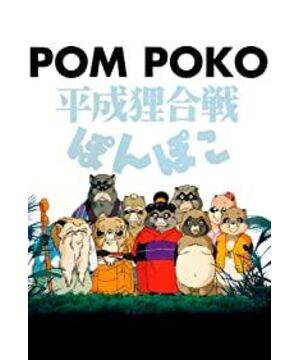Because it is a cat, of course, the film itself is also good, plus the date bonus, so I got five stars~
It’s been a long time since I wanted to watch it, and it’s been in my computer for a long time. Today The main reason for watching it is that I have a cold and there is not much to watch in the theater's recent film schedule (if I go to the theater, I guess it is to watch animations or watch Han Han), after struggling with it, I think it is more worthless to waste time than to waste the birthday discount of the theater membership card. Some... So I still don't plan to go out today, I tried it and found that I couldn't read the DVD, so the movies that I could watch today were locked in the ones I've already downloaded. I wanted to watch "Tokyo Godfather", but I found that there were no subtitles. So it is reasonable to watch "Variety Civet Cat".
However, the title is still called "The Battle of Heisei Tanuki", because compared to the less recognizable name of "Variety Tanuki", the "Heisei Tanuki Battle" directly copied from the Japanese title's Chinese characters is indeed the same as the whole film. That strong Japanese flavor is consistent. The whole movie is very Japanese.
There are two subtitles in addition to the title that are worth complaining. First, the civet cat was translated into a raccoon at the beginning. Although it may be, the subtitles still need consistency, and as far as I am concerned, I still tend to think that it is a cat. ...another place is that all the names are directly written in Roman accents... The following songs and other places will also appear in English from time to time (but at the same time there are also Chinese below), Roman accents, so long, I still spell it at first I gave up after a while...the end credits also accidentally have some Roman accents below...but I can't tell exactly what it means...
There are at least four forms of civet cats, the most animalized one looks like a raccoon (and an advanced version of an angry raccoon); the usual appearance is the civet cats wearing clothes, and the clothes are changed in various ways, leading to the civet cat at the beginning The internal battles seem to be especially joyful; when the civet cats are celebrating or in some other abnormal state, the style of painting becomes something that makes people think it is "painting collapsed", which is often the representative of the rabble. Well; in addition, it is the appearance of an adult, and of course there are some other changes. However, it may be due to the racial effect. I still feel a little blind. I can barely recognize the protagonist, the leader of the red party, the priest, and the old woman. It is not bad, thanks to the latter two. (At the end, it is introduced that the protagonist is working in the department, the leader of the red party is dead, the priest disguised as a human, and the protagonist's non-transformation partner has miraculously lived as a civet cat. What happened to the old woman? It seems that I didn't explain...? )
It was originally planned that it could be paused for a while, but it was broadcast smoothly. The whole process did not pause, which means that I can actually watch it in the theater today... Forget it...
But one of the reasons why it is suitable for watching "Heisei Tanabata" is that I just made up the "Onmyoji" of the dream-buying pillow tapir recently. ”, (although looking at it, I found that there are not only the first six books on loan, but fortunately they are basically independent stories.) There is more or less connection between the two. (It may not be obvious, but one manifestation is that I think the civet cat that became an onmyoji is especially handsome...) Although I like this kind of story (not a horror ghost story in the traditional sense, but from a non-human point of view or This kind of "ghost story" from the perspective of peace and equality) has been around for a while, but I have seen it a lot recently.
It's hard to say where this story wants us to stop, maybe it's a coexistence. On the one hand, before the subtitles came out (there is no content after the subtitles), a civet cat was left to tell us outside the four walls whether it could prevent further damage to their living environment. (As expected of a cartoon, even if a civet cat that broke the fourth wall was talking to the audience, I still didn't feel any horror, as if it wasn't talking to me at all, as if it wasn't looking at me at all, but look carefully. You will find that it is indeed looking at the camera.) This is a bit like where I saw that Hans Christian Andersen's fairy tale was written to a little girl who sold matches in a grade, but instead of selling matches, someone took care of them and told them the story little girl's. This sentence is also said to the children who may change the status quo in the future. I really like this layer. After all, people and cats are always on the side of cats than me~ (and I do often feel that at least from the perspective of the current situation in China, we have to wait for our generation to die before we can wash back the obvious thing of animal lives matter. ...and Ghibli contributed a lot to this.) On the other hand, the whole story is clearly aboriginal. When I first thought of the word aboriginal people, I thought about whether there are aboriginal people in Japan, and the conclusion is that there are, not only there, but also comparing the aboriginal people to civet cats, foxes, and so on. Do you still remember the legend that Abe Seimei's mother was a white fox? From this point of view, the final "destined to fail" ending is also very respectful of reality, instead of imposing a victory on them, but relying on this "not so bad" method to give one (of course, in fact Also "forced") HE that is barely like HE but can't be said to be HE. The third aspect is urbanization, which sounds the same as the first, but it’s more than that. Hayao Miyazaki seems to be very obsessed with the feeling of the Showa period. From the fox here to the “Spirited Away” There is also a chinchilla that only children can see. Many Japanese people are probably like this. Similar sayings are also common in places like "Wonderful Story of the World". Nostalgia is a theme that was always popular in the former world. Nostalgia for that era appears in various Miyazaki films. The same is true for the use of the second illusion, from Heisei back to Showa. (So it's a Heisei Tanuki battle.)
From a practical point of view, this is indeed the end, whether it is from an animal perspective (: Indeed, many small animals such as raccoons have integrated into urban life, and some cities have underground passages specially built for animals, which is the so-called common in the film. The city where we live), or from the perspective of the natives (: Historically the natives have always been driven farther, some have moved to more secluded places, and some have become indistinguishable from those who came after. Speaking of singing and dancing and witchcraft and so on It is also usually regarded as a feature of the aborigines), or from the perspective of urbanization (which eventually disappeared), the failure of the ending was foreseen, but we can't believe that Ghibli really respects reality so much. (I remember seeing a saying two days ago that Totoro is the god of death...) At the
end, I want to tell the children that the uncle with dark circles who sees an energy drink on the tram may be a civet cat? This is very cute, lol~ When the three masters came, they were not low-key at all. For the sake of graduation, some civet cats disguised as a person and went to work at the construction site, some disguised as monks, some went to work in Fengyuechang, some were addicted to small steel beads, and some went to temples to steal money. Humans have no mercy when killing civet cats, and civet cats are also very excited when they kill humans. Although I don’t think both are suitable, at least there is no civet cat to talk about the civet cat’s heart of the Virgin of silence. In the end, the protagonist Tanuki said in the narration, "How can humans maintain this kind of life?" It is also considered a black humor, but at this time, it is impossible to laugh.
But I still have tears in my eyes...
The part of sailing to death by boat is especially sad. As far as the two people from Shikoku are concerned, it is true that they died in a foreign land. It is really a disaster... In the end, they still lost, and I feel that the one who died in the parade died in vain...
I like it very much. It is "a civet cat is not a civet cat without a playful spirit", although it is probably not the point at all, but probably because it is particularly suitable for me, I should remind myself to remember the fun spirit in the new year~
Being an animation has some advantages in performance, and this film always makes good use of it, such as the excavator bulldozer shrinks and bites a leaf like a bug, and the background is the new city. Although the civet cat on behalf of Ghibli at the end asked us if you could stop it, the whole film did not directly portray humans as 100% villains (of course, mainly because the audience is human), of course, this kind of story originally did not exist. villain. I always look at the civet cat from the perspective of a human being. The human population is increasing, and humans want to move away if possible. Humans are very happy to return to the Showa period... But it seems that everyone and every civet cat is still the same. Being pushed to such an end by force majeure, the only thing I can do is to remember to have fun. Things like a symbiotic relationship were also mentioned from the very beginning, civet cats choose to live in places where humans live, but of course not for stealing. There is also a pixel-style animation in the back to explain the part of the tanuki's habitat reduction. In addition, the passage of Hundred Ghosts Night seems to be a common passage in Japanese animation movies. It is similar in "Red Pepper", and I especially like it, especially when two people are drinking and discussing this matter as a prospect. Hundreds of ghosts are constantly walking at night, and the composition seems to be the background, but in fact, they are the main body that is constantly changing. This part is really great. I remembered a short film about a group of ghosts having a party on the bus that I wanted to make before I read such a story and heard such a word (I didn't actually do it), probably from the "collective subconsciousness of such a ghost walking at night" "Bar.
But as expected, it was regarded as a pleasant parade. Rather than a disaster accident or a ghost story that was not clear at all, it was better to say that it was an illusion. If there was any harm, it was regarded as an entertainment or commercial activity for granted. . I don't know why I stopped killing people in this way after a few people died at the beginning. If someone "stealed the fruits of the revolution", shouldn't it be reasonable to pretend to make a statement or even directly kill this person to prove the wrath of God? ? But no, the later ghosts are harmless, and when they clashed with the police, they also chose the most inappropriate method of "smashing stones with eggs". There is no doubt about losing. I used to think I was a human protectionist... and it was the foxes who found them first. The foxes are more difficult to adapt and change faster. But if in the end it is all about disguising as a human to work, why didn't you just follow the fox's way, at least it's more expensive, and ah, why don't you ask to keep the forest from this aspect, can't you just find a way to buy it... ...?
It can be understood that as an animation, it is always inconvenient to kill people all the time, but the same content that is not suitable for children, but every spring, "it's mating season again", I thought it was just negligence when I saw other animals ooxx, (like The sheep in the roadside socialist advertisements...) But it really isn't... and the male cat's testicles are really full of drama... If this is sterilized...
After all, family planning and planned economy have appeared here... In the parts that don't look like Chinese characteristics, female independence also appeared. Of course, the first two should not appear for the sake of Chinese characteristics. It is probably a transformation from "civet cats" to more like "humans". Immediately afterwards, when the leader of the Red Party was going to be a dictatorship, and he must be called Mr., I thought I was going to go this way. (I didn't expect him to go the way of Sediq Bale in the end... but I haven't seen it and can't be sure.) Later, I don't know how to get rich in real estate by selling forests to developers. Since there are forests Why can't the ownership of the forest be preserved like this in the first place...? However, during the family planning period, I was very worried about the mouth structure of civet cats, and later it became a baby boom. However, the family planning of civet cats cannot be copied from humans. One is because humans are not perfect, and the other is because civet cats can't be copied at once. I gave birth to several, and their lifespans are also different...
In the end, the reporters of the TV station only serve as a medium for the audience to see, and have no role in the film. But if Miyazaki really didn't believe in the role of the media, he wouldn't do it this way.
In some places, the sound and the picture are not quite right, and in addition, it is always carried out with the narration telling the story. The narration makes the story more like a story that has been told, but at the same time, the clear year is true. Gives a sense of authenticity.
When the two children in the "Gemini" project described their interstellar adventures, they felt like paying homage to "Nights on the Galactic Railroad". I don't know if it was an illusion.
I don't know what the story of the hunter before the attack is used for, but this section has a very artistic feel to it.
The part of Hundred Ghosts Night Walk is also very beautiful, and there is nothing else to say. It's strange why a human old man can scare people at the toilet door...
The fox said "If you swallow poison, why not swallow the whole bottle". At first glance, it makes sense that it can be used to install B, but it is not particularly clear when you think about it... Later, how much was allocated in the abacus? I can't understand it very well...
The music is also very good. On the one hand, it cooperates well with the picture, on the other hand, it is harmonious, and it has a lyrical effect. It is said that the farewell tune was used when sending off two young people for a long journey, and I didn't hear one sentence at all... But in the end, this seemingly happy ending of singing and dancing, is it true? That's probably not what a kid watching a movie needs to think about, and it's not something I want to think about...
View more about Pom Poko reviews











